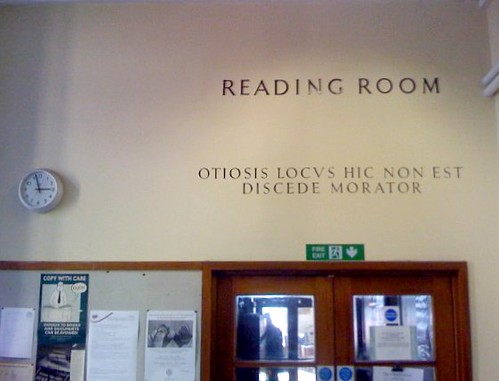 "This is no place for idleness - be gone, time waster" |
| Image via Flickr user Alastair Dunning. |
The Library emerged as a weapon of enlightenment against orthodox dogmatism: Luther; the French Revolution; Sciences; Liberating the right to think for oneself.Thus wrote Aby Warburg about his library. The eldest son of a prominent German banking family, he ceded his right to the family business to his brother on the condition that he was to be bought any book he required for his studies. Around his profound interest in how the art and culture of the ancient world had influenced the development of Western civilization, the library grew up. Ultimately, he developed his personal collection into the library at the heart of a research institute, attracting a community of renowned scholars, their output and the library continuing after his death in 1929. With the rise of the Nazis, the entire library and its staff were clandestinely shipped to London, where, after several moves, it settled in Woburn Square. Its dedicated home is, to this day, a strange world of Latin notices, renaissance images, free-flowing tea and holistic classification.
It was the notice welcoming researchers to afternoon tea that we first noticed when we entered the Institute - a sign that the Warburg's sense of scholarly community is as alive as ever. After prying several excited members of our party away from the noticeboard of events, we were welcomed by our fellow trainee Raphaelle. We first visited the downstairs reading room, home to the recent periodicals and general reference volumes, and all overlooked by a large sign painted on the walls in Latin urging readers to maintain a scholarly silence. There we were introduced to assistant librarian Dr. François Quiviger, who told us about the history of the library, and about its unique structure and classification system. Having been established from a researcher's private collection and created as an institute for and by researchers, until relatively recently the librarians held no formal LIS qualifications, but were instead researchers active in the fields covered by the library. To this day, many of the staff are also academically active. Dr. Quiviger also explained the structure of the library. Arising from Aby Warburg's own arrangement of his books, the library aims to organise knowledge not in alphabetical order, by place or by person, but rather by flow and reaction. Books are arranged under four principles: Image, Word, Orientation and Action, meant to replicate the flow of human ideas from their perception to their explication, to the responses and reactions they engender. The floors of the library are arranged according to these principles, beginning with Image on the 1st, Word on the 2nd, etc. Dr. Quiviger illustrated how a researcher could physically follow the progression of an idea from the ancient world onwards along shelves and floors. However, despite this holistic arrangement, the books are now catalogued by standard Anglo-American rules, the library having transferred from a system which required the use of Latin accidence...
 |
| The Warburg Institute Library classification scheme |
We were also shown the Warburg's iconographic database of images drawn from the Institute's photographic collection and library. The Warburg has consistently been at the forefront of digitisation, and this database in progress allows for either classified or keyword searching of images ancient, mediaeval, renaissance and beyond. This runs in tandem with the Warburg's long-running book digitisation project, which allows them to make otherwise fragile or rare works available easily to researchers either as online PDFs or as durable reprints on the library shelves.
Afterwards, we were taken on a tour of the library by Raphaelle, where we met other members of library staff who explained the library's policies on periodicals, acquisitions and conservation. The latter included some discussion of the library's (at times controvertial) policy of rebinding some damaged or fragile works to allow them to remain in use in the library, rather than risking the volumes becoming unavailable while attempting to maintain the original binding. This triggered a lively discussion about our own libraries policies with regard to repair, conservation and circulation. This was followed by further discussion of the library over tea in the Warburg's welcoming common room.
No comments:
Post a Comment
Note: only a member of this blog may post a comment.